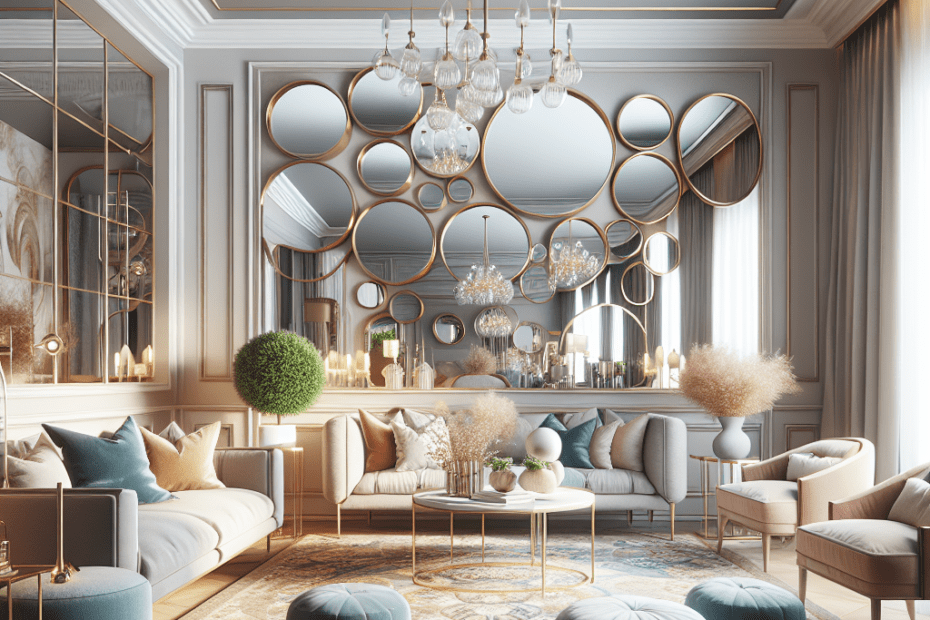“`html
Mirrors in Interior Design: Expanding Your Space
When it comes to enhancing a room’s aesthetic, mirrors in interior design are a powerful tool that can transform any space. People often overlook the simple yet effective nature of mirrors to expand and brighten their environments. By placing them strategically, mirrors not only add depth and dimension but also create the illusion of a larger area. According to a study by the Home Improvement Research Institute, 47% of homeowners emphasized using mirrors to make small spaces appear bigger. This is a testament to their increasing popularity in modern décor.
The Science Behind Mirrors in Making Spaces Look Larger
Mirrors reflect light and images, tricking the eye into perceiving more space than there actually is. This optical illusion can magnify rooms’ size, especially when used correctly. The reflective surface can multiply the ambient light in the room, making it feel more open and airy. Designers emphasize that placing mirrors opposite windows maximizes this effect by bringing in more natural light. Moreover, mirrors can direct attention, deflecting focus from cramped areas to the broad reflective surfaces.
Practical Tips for Using Mirrors in Interior Design
Although mirrors are versatile, placement is essential in achieving the desired effect. Here are some practical tips:
- Choose the Right Size: A larger mirror can be more effective in creating a sense of space. However, it’s important to ensure it’s proportionate to the room size.
- Consider the Room’s Function: Mirrors in a hallway can make it feel bigger and less claustrophobic, while in a dining room, they can add elegance.
- Reflect Natural Light: Position mirrors so that they bounce natural light around the room.
- Create Artistry: Use artisanal frames to make mirrors a focal point and an art piece, enhancing the room’s aesthetic without overwhelming it.
Common Mirror Placement Ideas
There are numerous ways to use mirrors in different parts of your home, with some popular ideas including:
| Area | Mirror Placement |
|---|---|
| Living Room | Large mirrors above the sofa or fireplace to reflect light and add grandeur. |
| Bedroom | Wall-length mirrors to create an open feel, especially if the space is small. |
| Bathroom | Place frameless mirrors for a sleek, modern look that can make the bathroom feel luxurious. |
| Entryway | Using a mirror can give a welcoming feel as it reflects light and space as you enter. |
Selecting the Perfect Mirror Style
Selection of mirror style should also reflect personal taste while complementing the home’s design scheme:
- Framed Mirrors: They can be traditional or contemporary, and frames can tie into existing room themes.
- Frameless Mirrors: Offer a minimalist vibe, ideal for modern or industrial-style interiors.
- Antique Mirrors: They add charm and character, making them great for vintage-inspired spaces.
Importance of Mirror Quality and Maintenance
The quality of the mirror is crucial as it affects the clarity and sustainability. High-quality mirrors resist tarnishing and maintain their reflective abilities over time. Maintenance is also key; clean mirrors regularly using appropriate cleaning agents to prevent smudges and streaks, ensuring they remain an attractive feature in any room.
Key Takeaways
- Mirrors effectively create the illusion of space and amplify light in a room.
- Strategic placement—like opposite windows—enhances their optical impact.
- Different mirror styles and sizes suit various design needs and personal preferences.
- High-quality mirrors provide longevity and require regular maintenance to look their best.
FAQs
- What type of mirror is best for small spaces?
Large wall mirrors are usually best, as they maximize the sense of space by reflecting more of the room.
- Can mirrors work in windowless rooms?
Yes, by reflecting artificial light, mirrors can still enhance the sense of space in windowless rooms.
- How high should a mirror be hung?
This depends on the furniture nearby but generally at eye level to be effective.
- What shape of mirrors work best?
Rectangular or square mirrors can offer a clean look, while round mirrors add a softer, decorative feel.
- Is there a downside to using too many mirrors?
Yes, too many mirrors can make a space feel cluttered and disorienting. Balance is key.
“`
This blog post delivers a comprehensive understanding of how mirrors in interior design enhance spatial perception while providing practical advice on their usage. The FAQ section addresses common concerns readers may have, ensuring informed decisions and successful interior transformations.
